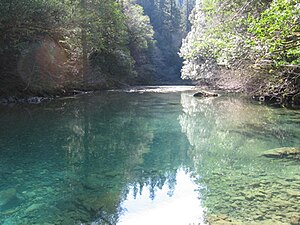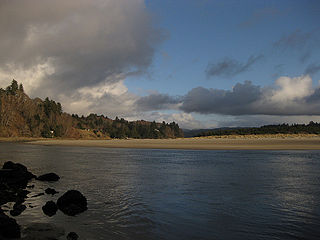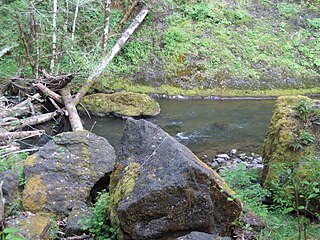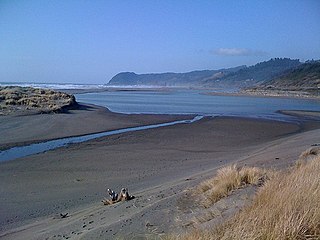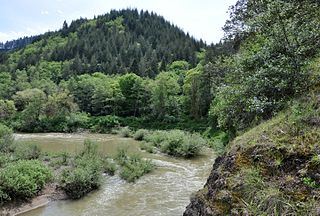| Winchuck River | |
The Winchuck River | |
| Name origin:Uncertain. Possibly the Chinook Jargon term for windy water. Possibly the local native name for woman. [1] | |
| Country | United States |
|---|---|
| State | Oregon |
| County | Curry County, Oregon and Del Norte County, California |
| Source | confluence of Bear and Salmon creeks |
| - location | Curry County, Siskiyou National Forest , Oregon |
| - elevation | 164 ft (50 m) [2] |
| - coordinates | 42°01′09″N124°06′20″W / 42.01917°N 124.10556°W [3] |
| Mouth | Pacific Ocean |
| - location | Crissey Field State Recreation Site, Curry County, Oregon |
| - elevation | 7 ft (2 m) [3] |
| - coordinates | 42°00′18″N124°12′55″W / 42.00500°N 124.21528°W Coordinates: 42°00′18″N124°12′55″W / 42.00500°N 124.21528°W [3] |
| Length | 10 mi (16 km) [4] |
| Basin | 71.3 sq mi (185 km2) [5] |
| Discharge | |
| - average | 494 cu ft/s (14 m3/s) [4] |
The Winchuck River (Tolowa: duu-sr-xuu-shi taa-ghin-li~' [6] ) is a short coastal stream that runs through the Rogue River–Siskiyou National Forest to the Pacific Ocean in the U.S. states of Oregon and California. Flowing generally west from its origin near Elk Mountain, the river enters the sea at Crissey Field State Recreation Site, [7] about 1⁄2 mile (0.80 km) north of the Oregon–California border and about 5 miles (8 km) south of Brookings. [8]
The Tolowa language is a member of the Pacific Coast subgroup of the Athabaskan language family. Together with three other closely related languages it forms a distinctive Oregon Athabaskan cluster within the subgroup.

The Rogue River–Siskiyou National Forest is a United States National Forest in the U.S. states of Oregon and California. The formerly separate Rogue River and Siskiyou National Forests were administratively combined in 2004. Now, the Rogue River–Siskiyou National Forest ranges from the crest of the Cascade Range west into the Siskiyou Mountains, covering almost 1.8 million acres (7,300 km2). Forest headquarters are located in Medford, Oregon.

The Pacific Ocean is the largest and deepest of Earth's oceanic divisions. It extends from the Arctic Ocean in the north to the Southern Ocean in the south and is bounded by Asia and Australia in the west and the Americas in the east.
Contents
Formed by the confluence of Fourth of July Creek and Bear Creek in southern Curry County, the river flows generally west. Just below the source, Salmon Creek enters from the left, then Elk Creek and Deer Creek enter from the right. Further downstream, the Winchuck receives Moser Creek and the South Fork Winchuck River, both from the left. The river then leaves Oregon, flowing in Del Norte County, California, for a short distance before re-entering Oregon. The Winchuck passes under U.S. Route 101 in Oregon just before reaching the ocean. Winchuck River Road runs along or near the north side of the river for much of its course. [9]
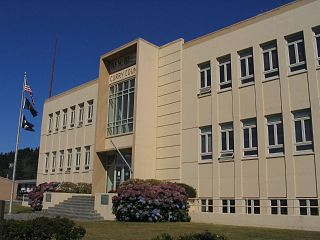
Curry County is a county in the U.S. state of Oregon. As of the 2010 census, the population was 22,364. The county seat is Gold Beach. The county is named for George Law Curry, a governor of the Oregon Territory.
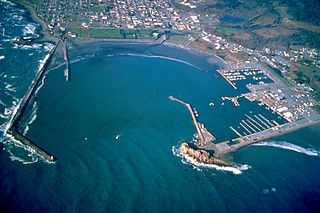
Del Norte County is a county at the far northwest corner of the U.S. state of California, along the Pacific Ocean adjacent to the Oregon border. As of the 2010 census, the population was 28,610. The county seat and only incorporated city is Crescent City. Del Norte was pioneered and settled by Azorean Portuguese explorers and dairy farmers, which may account for the local pronunciation of the county name. Residents pronounce the county name as Del Nort, not Del Nor-teh as would be expected in Spanish.

U.S. Route 101 (US 101), is a major north–south U.S. Highway in Oregon that runs through the state along the coastline near the Pacific Ocean. It runs from the California border, south of Brookings, to the Washington state line on the Columbia River, between Astoria, Oregon, and Megler, Washington.
The main stem and tributaries support chinook and coho salmon, steelhead, and sea-run coastal cutthroat trout. [10] Access for fishing is limited, especially along the lower stretches of the river. Fishing from boats is not allowed, but Winchuck River Road provides public access in places. [11]

The Chinook salmon is the largest species in the Pacific salmon genus Oncorhynchus. The common name refers to the Chinookan peoples. Other vernacular names for the species include king salmon, Quinnat salmon, spring salmon, chrome hog, and Tyee salmon. The scientific species name is based on the Russian common name chavycha (чавыча).

The coho salmon is a species of anadromous fish in the salmon family, one of the several species of Pacific salmon. Coho salmon are also known as silver salmon or "silvers". The scientific species name is based on the Russian common name kizhuch (кижуч).

The rainbow trout is a trout and species of salmonid native to cold-water tributaries of the Pacific Ocean in Asia and North America. The steelhead is an anadromous (sea-run) form of the coastal rainbow trout(O. m. irideus) or Columbia River redband trout (O. m. gairdneri) that usually returns to fresh water to spawn after living two to three years in the ocean. Freshwater forms that have been introduced into the Great Lakes and migrate into tributaries to spawn are also called steelhead.
Flora in the watershed's forests include Douglas-fir, bigleaf maple, and madrone, typical of the Southern Oregon Coast Range, the coastal Siskiyou Mountains, and the Redwoods Zone. [12] Most of Oregon's remaining coast redwood forest lies within the Winchuck drainage. [10] Sensitive fauna in the watershed include the spotted owl and marbled murrelet. [5]
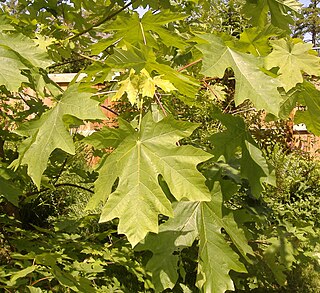
Acer macrophyllum, the bigleaf maple or Oregon maple, is a large deciduous tree in the genus Acer.

Arbutus is a genus of 12 accepted species of flowering plants in the family Ericaceae, native to warm temperate regions of the Mediterranean, western Europe, the Canary Islands and North America. The name Arbutus was taken from Latin, where it referred to Arbutus unedo.

The Southern Oregon Coast Range is the southernmost section of the Oregon Coast Range, in the Pacific Coast Ranges, located in the southwest portion of the state of Oregon, United States, roughly between the Umpqua River and the middle fork of the Coquille River, beyond which are the Klamath Mountains. To the east is the Umpqua Valley and to the west the Pacific Ocean. This approximately 55-mile (89 km)-long mountain range contains mountains as high as 3,547 feet (1,081 m) for Bone Mountain. The mountains are known locally in the Roseburg area as the Callahan Mountains, or simply as The Callahans.
